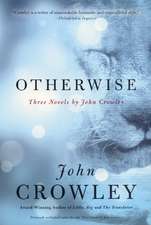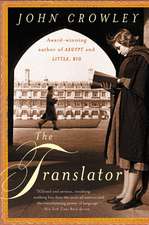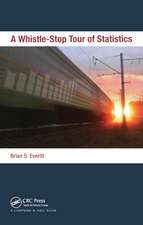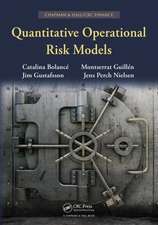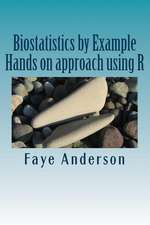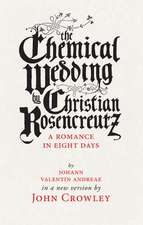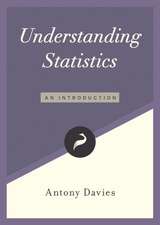Handbook of Statistics in Clinical Oncology
Editat de John Crowleyen Limba Engleză Paperback – 12 sep 2017
Addressing the many challenges that have arisen since the publication of its predecessor, this third edition covers the newest developments involved in the design and analysis of cancer clinical trials, incorporating updates to all four parts:
- Phase I trials: Updated recommendations regarding the standard 3 + 3 and continual reassessment approaches, along with new chapters on phase 0 trials and phase I trial design for targeted agents.
- Phase II trials: Updates to current experience in single-arm and randomized phase II trial designs. New chapters include phase II designs with multiple strata and phase II/III designs.
- Phase III trials: Many new chapters include interim analyses and early stopping considerations, phase III trial designs for targeted agents and for testing the ability of markers, adaptive trial designs, cure rate survival models, statistical methods of imaging, as well as a thorough review of software for the design and analysis of clinical trials.
- Exploratory and high-dimensional data analyses: All chapters in this part have been thoroughly updated since the last edition. New chapters address methods for analyzing SNP data and for developing a score based on gene expression data. In addition, chapters on risk calculators and forensic bioinformatics have been added.
| Toate formatele și edițiile | Preț | Express |
|---|---|---|
| Paperback (1) | 441.88 lei 6-8 săpt. | |
| CRC Press – 12 sep 2017 | 441.88 lei 6-8 săpt. | |
| Hardback (1) | 892.23 lei 6-8 săpt. | |
| CRC Press – 26 mar 2012 | 892.23 lei 6-8 săpt. |
Preț: 441.88 lei
Preț vechi: 519.86 lei
-15% Nou
Puncte Express: 663
Preț estimativ în valută:
84.56€ • 90.42$ • 70.50£
84.56€ • 90.42$ • 70.50£
Carte tipărită la comandă
Livrare economică 17 aprilie-01 mai
Preluare comenzi: 021 569.72.76
Specificații
ISBN-13: 9781138199491
ISBN-10: 1138199494
Pagini: 658
Ilustrații: 96
Dimensiuni: 156 x 234 x 40 mm
Greutate: 0.86 kg
Ediția:Revised
Editura: CRC Press
Colecția Chapman and Hall/CRC
Locul publicării:Boca Raton, United States
ISBN-10: 1138199494
Pagini: 658
Ilustrații: 96
Dimensiuni: 156 x 234 x 40 mm
Greutate: 0.86 kg
Ediția:Revised
Editura: CRC Press
Colecția Chapman and Hall/CRC
Locul publicării:Boca Raton, United States
Cuprins
Choosing a Phase I Design. Dose Finding Designs Based on the Continual Reassessment Method. Pharmacokinetics in Clinical Oncology: Statistical Issues. Statistics of Phase 0 Trials. CRM Trials for Assessing Toxicity and Efficacy. Seamless Phase I/II Trial Design for Assessing Toxicity and Efficacy for Targeted Agents. Overview of Phase II Clinical Trials. Designs Based on Toxicity and Response. Designs Using Time to Event Endpoints/Single Arm versus Randomized Phase II. Phase II Selection Designs. Phase II with Multiple Subgroups: Designs Incorporating Disease Subtype or Genetic Heterogeneity. Phase II/III Designs. On Use of Covariates in Randomization and Analysis of Clinical Trials. Factorial Designs with Time to Event Endpoints. Early Stopping of Clinical Trials. Noninferiority Trials. Phase III Trials for Targeted Agents. Adaptive Trial Designs. Design of a Clinical Trial for Testing the Ability of a Continuous Marker to Predict Therapy Benefit. Software for Design and Analysis of Clinical Trials. Cure-Rate Survival Models in Clinical Trials. Design and Analysis of Quality of Life Data. Economic Analyses alongside Cancer Clinical Trials. Structural and Molecular Imaging in Cancer Therapy Clinical Trials. Prognostic Factor Studies. Predictive Modeling of Gene Expression Data. Explained Variation and Explained Randomness for Proportional Hazards Models. Prognostic Groups by Tree-Based Partitioning and Data Refinement Methods. Risk Calculators. Developing a Score Based upon Gene Expression Profiling and Validation. Analysis of DNA Microarrays. Methods for SNP Regression Analysis in Clinical Studies: Selection, Shrinkage, and Logic. Forensic Bioinformatics. Index.
Notă biografică
John J. Crowley is president and CEO of Cancer Research and Biostatistics (CRAB), Seattle, Washington, director of the SWOG Statistical Center, and a faculty member at the Fred Hutchinson Cancer Research Center. The author or coauthor of more than 350 refereed articles, book chapters, and other publications, Dr. Crowley is a fellow of the American Statistical Association and the American Association for the Advancement of Science and a member of the International Biometrics Society, the American Society for Clinical Oncology, and the International Association for the Study of Lung Cancer. He received his BA (1968) from Pomona College, Claremont, California, and his MS (1970) and PhD (1973) in biomathematics from the University of Washington, Seattle.
Antje Hoering, PhD, is a senior biostatistician at Cancer Research and Biostatistics (CRAB), Seattle, Washington. She is also an affiliate faculty member in the Department of Biostatistics at the University of Washington and an affiliate investigator at the Fred Hutchinson Cancer Research Center. Dr. Hoering is the lead statistician of the SWOG Myeloma Committee, the SWOG Early Therapeutics Subcommittee, and the Stand Up To Cancer, Pancreatic Dream Team. She is the coordinating statistician for the Myeloma Institute for Research and Therapy, the International Myeloma Committee, and the Pancreatic Cancer Research Team. She serves as a consultant on a variety of industry-sponsored studies and has been the biostatistics representative on two Type B meetings with the FDA. She is member of the American Statistical Association, the International Biometrics Society, and the International Myeloma Society. She received her BS (1985) from the University of Tubingen, Germany, her MS (1988) in physics from Oregon State University, Corvallis, and her PhD (1991) in physics from the Max Planck Institute for Theoretical Nuclear Physics, Heidelberg, Germany. She transitioned into biostatistics with a three-year NRSA postdoctoral fellowship with the Department of Biostatistics at the University of Washington and the Fred Hutchinson Cancer Research Center.
Antje Hoering, PhD, is a senior biostatistician at Cancer Research and Biostatistics (CRAB), Seattle, Washington. She is also an affiliate faculty member in the Department of Biostatistics at the University of Washington and an affiliate investigator at the Fred Hutchinson Cancer Research Center. Dr. Hoering is the lead statistician of the SWOG Myeloma Committee, the SWOG Early Therapeutics Subcommittee, and the Stand Up To Cancer, Pancreatic Dream Team. She is the coordinating statistician for the Myeloma Institute for Research and Therapy, the International Myeloma Committee, and the Pancreatic Cancer Research Team. She serves as a consultant on a variety of industry-sponsored studies and has been the biostatistics representative on two Type B meetings with the FDA. She is member of the American Statistical Association, the International Biometrics Society, and the International Myeloma Society. She received her BS (1985) from the University of Tubingen, Germany, her MS (1988) in physics from Oregon State University, Corvallis, and her PhD (1991) in physics from the Max Planck Institute for Theoretical Nuclear Physics, Heidelberg, Germany. She transitioned into biostatistics with a three-year NRSA postdoctoral fellowship with the Department of Biostatistics at the University of Washington and the Fred Hutchinson Cancer Research Center.
Recenzii
"A strength of the handbook is the large number of examples that are included in most chapters that expand on the theoretical basis underpinning the relevant methodology. Each chapter provides details of new developments in the specific methodology and provides a comprehensive list of references for the reader to seek further information when required. … The book contains a wealth of information about a wide range of statistical methodologies, some of which are not limited to clinical trials. … a valuable update to a resource that covers a comprehensive range of topics related to the design, analysis and interpretation of clinical trials in cancer research."
—Peter Baade, Australian & New Zealand Journal of Statistics, 2013
Praise for the Second Edition:
"The new topics and contributions in this edition include the recently developed tools for high-dimensional data and bioinformatics in clinical oncology research. A new section has been added emphasizing the importance and rapid developments of these topics over the 5 years since the publication of the first edition. Some of the original sections have been updated to include the state-of-the-art knowledge and tools in all topics. The end result is a comprehensive edited volume covering statistical and bioinformatics methods that provide the foundation for important research and clinical trials in cancer. … Like the last edition, this current edition will be an important addition to the libraries of all health research centers. The book will be prized as a reference book for biostatisticians, biomedical researchers, and oncologists for planning, conducting, analyzing, and interpreting cancer research."
—Journal of the American Statistical Association, Vol. 104, No. 487, September 2009
"This is a expanded and revised second edition of a text that was initially well received by the community. The book comprised of 33 chapters, grouped into 6 sections. … The text is extremely well referenced. The authorship represents the leaders in the field. A significant strength of this book is its example-driven approach to the ‘out-of-the-box’ but practical issues faced by those conducting cancer clinical trials. The book provides a critical assessment of the state of science through a thorough review of the methods, applications, and available resources. … a detailed and mostly comprehensive text on the topics of cancer clinical trial design, conduct, analysis, and interpretation."
—Daniel Sargent, Sumithra Mandrekar, and Ann Oberg, Mayo Clinic, Biometrics, December 2006
"This huge book is a work of many famous and high-skilled scientists and was edited by John Crowley and Antje Hoering. It consists of four big parts. The first 3 parts cover the statistical methods, issues and trial designs which are applicable for Phase I, Phase II and Phase III clinical trials respectively. In the fourth chapter, numerous topics related to exploratory and high dimensional data analysis are described."
~Attila Dávid (HU), International Society for Clinical Biostatistics
—Peter Baade, Australian & New Zealand Journal of Statistics, 2013
Praise for the Second Edition:
"The new topics and contributions in this edition include the recently developed tools for high-dimensional data and bioinformatics in clinical oncology research. A new section has been added emphasizing the importance and rapid developments of these topics over the 5 years since the publication of the first edition. Some of the original sections have been updated to include the state-of-the-art knowledge and tools in all topics. The end result is a comprehensive edited volume covering statistical and bioinformatics methods that provide the foundation for important research and clinical trials in cancer. … Like the last edition, this current edition will be an important addition to the libraries of all health research centers. The book will be prized as a reference book for biostatisticians, biomedical researchers, and oncologists for planning, conducting, analyzing, and interpreting cancer research."
—Journal of the American Statistical Association, Vol. 104, No. 487, September 2009
"This is a expanded and revised second edition of a text that was initially well received by the community. The book comprised of 33 chapters, grouped into 6 sections. … The text is extremely well referenced. The authorship represents the leaders in the field. A significant strength of this book is its example-driven approach to the ‘out-of-the-box’ but practical issues faced by those conducting cancer clinical trials. The book provides a critical assessment of the state of science through a thorough review of the methods, applications, and available resources. … a detailed and mostly comprehensive text on the topics of cancer clinical trial design, conduct, analysis, and interpretation."
—Daniel Sargent, Sumithra Mandrekar, and Ann Oberg, Mayo Clinic, Biometrics, December 2006
"This huge book is a work of many famous and high-skilled scientists and was edited by John Crowley and Antje Hoering. It consists of four big parts. The first 3 parts cover the statistical methods, issues and trial designs which are applicable for Phase I, Phase II and Phase III clinical trials respectively. In the fourth chapter, numerous topics related to exploratory and high dimensional data analysis are described."
~Attila Dávid (HU), International Society for Clinical Biostatistics
Descriere
The third edition presents up-to-date statistical approaches to the design and analysis of oncology clinical trials. New topics include trial designs for targeted agents, Bayesian trial design, and the inclusion of high-dimensional data and imaging techniques. It also contains numerous figures and examples to better explain concepts.

